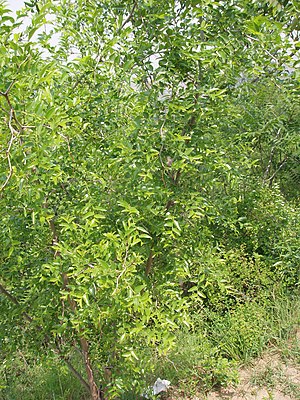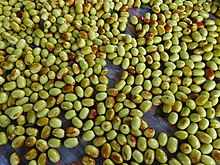Chinese jujube
| Chinese jujube | ||||||||||||
|---|---|---|---|---|---|---|---|---|---|---|---|---|

Chinese jujube ( Ziziphus jujuba ) |
||||||||||||
| Systematics | ||||||||||||
|
||||||||||||
| Scientific name | ||||||||||||
| Ziziphus jujuba | ||||||||||||
| Mill. |
The Chinese jujube ( Ziziphus jujuba Mill. ), Also Chinese Date (or Kumul-date), Red date , Azufaifa or Ber called, is a plant from the family of the cross thorn plants (Rhamnaceae). It comes from north and north-east China and is cultivated worldwide today.
description
The Chinese jujube is a tree or, less commonly, a shrub that reaches heights of up to 10 meters. He's long and short spines or without thorns and branches long. The rough, longitudinally cracked to scaly bark is brown to gray-brown. The bark of young, flexible branches is purple-red or gray-brown and soft. The stipules are transformed into two thorns or are completely absent. Long thorns are straight and up to 3 inches long. Short thorns develop on older branches and are bent over.
The flowering period extends from May to July, the fruit ripening from August to October. The number of chromosomes is 2n = 24. However, polyploidy with 2n = 36 or 2n = 48 is common.
leaves
The alternate leaves are 1 to 6 millimeters long and stalked, and up to 1 centimeter long on young shoots . They are bald on top and sparsely hairy on the underside. The egg-shaped to egg-lanceolate, elliptical or rounded leaf blades are light green ( abaxial ) and dark green on top (adaxial). They are between 3 and 7 inches long and 1.5 to 4 inches wide and three-veined , paper-like, with a slightly uneven, rounded to blunt base. The leaf margin is finely serrated and the tip rounded to blunt, more rarely pointed or pointed.
Inflorescences and flowers
The flowers stand individually or in pairs to eight in axillary, short-stalked zymous inflorescences .
The flower stalks are between 2 and 3 millimeters long. The hermaphroditic flowers with a double perimeter are five-fold, glabrous and yellow-green in color. The discus is thick, fleshy, and five-lobed. The sepals are broad-shaped and central, adaxially keeled and rounded. The small, spatula and hood-shaped, narrow petals are arranged alternately to the sepals and are about as long as the stamens that sit at the edge of the discussion. The ovary is semi-protruding and slightly sunk into the discus. The two- branched style is split up to about half.
Fruits and seeds
Orange-red to red or red-purple drupes are formed. They are elongated to narrowly ovoid and between 2 and 3.5 inches long and 1.5 to 2 inches in diameter. The mesocarp is floury, fleshy and thick. It tastes mildly sweet or slightly sour. The light brown, wrinkled stone core is pointed to rounded at both ends. It contains two chambers and is one or two seeded. The orange-brown seeds are flattened-elliptical and about 10 millimeters long and 8 millimeters wide.
Chinese dates for sale in a market in Beijing
Varieties
There are four known varieties
- Ziziphus jujuba var. Jujuba : with thorns, sweet fruits
- Ziziphus jujuba var. Inermis (Bunge) Rehder : without thorns, sweet fruits
- Ziziphus jujuba var. Spinosa (Bunge) HHHu ex HFChow : with thorns, sour, smaller fruits, smaller leaves
- Ziziphus jujuba var. Tortuosa C.Y. Cheng & MJ Liu : without thorns, with gnarled branches and much smaller fruits
distribution
The Chinese jujube grows in the mountains and on hills, in sunny, dry places at altitudes of up to 1,700 meters. The area of origin of the plant is in the north and northeast of the People's Republic of China. From there it was introduced first to Korea, then to Japan , and later to Northwest India and Southeast Europe. Today they can also be found in the entire Mediterranean region as far as southern Switzerland and South Tyrol as well as in Vietnam , India, Georgia , Afghanistan , Sudan , Brazil and the southern USA .
History and use
In China they were already described in Shennong ben cao jing under the name Zao (枣) as an important medicinal drug. There, and derived from it in the further tradition, the jujube fruits (also called Chinese dates ) were ascribed to strengthen digestion, to strengthen health after an illness and to have a life-prolonging effect if taken regularly.
In Korean cuisine , the fruits are called Daechu ( 대추 ) and are used for teas and samgyetang for chicken soup . In the Taiwanese cuisine , fruits are also used for soups and teas.
Jujube found its way to the Mediterranean region in ancient times. Pliny reported about them:
- “The breastberries and the tuberes, which both recently came to Italy, these from Africa and those from Syria, are also foreign. Sextius Papinius, whom I knew as consul, first brought them to us in the last years of the Emperor Augustus' life and had them planted in the camp. They are more like berries than apples, but they serve as a great ornament for the walls, because they already reach the roofs. "
The positive effect of jujube fruits on the breast and on the lungs was first described by Gargilius Martialis and later confirmed by Arab authors .
In the 16th century the fruits were known in Central Europe as " breast berries" ( Hieronymus Bock ) or "red breast beerlin" ( Clusius and Dodoens ). At Krünitz you can find detailed information about red, black and white breast berries.
Today the jujube is naturalized in the Mediterranean region, Southeast Europe and Asia Minor, in Central Europe it only thrives in areas with a wine-growing climate, its fruits only ripen there in years with many warm summer days. The northern Italian town of Arquà Petrarca near Padua , where the "Festa delle Giuggiole" takes place once a year in autumn, is particularly known for the harvest of "breastberries" (Italian = giuggiole) . There various products are made from the fruit, such as schnapps and jams. When dried, the fruits are used as breast tea for colds ; for this reason they are often known as breast berries by pharmacists . The ziziphin contained in the leaves inhibits the sweet taste.
swell
- China: Stuart 1911
- Antiquity - late antiquity: Pliny 1st century --- Columella 1st century --- Galen 2nd century --- Gargilius Martialis 3rd century
- Arab Middle Ages: Avicenna 11th century --- Abdul ibn Butlan 11th century --- Pseudo-Serapion 13th century
- Modern times: Hieronymus Bock 1546 --- Mattioli / Handsch / Camerarius 1586 --- Nicolas Lémery 1699/1721 --- William Cullen 1789/90 --- Jean-Louis Alibert 1805/05 --- Hecker 1814/15
Historical illustrations
Jujube ( Ziziphus jujuba ). In: Abdul ibn Butlan . Tacuinum sanitatis in medicina. 13th century, Codex Vindobonensis Series Nova 2644, sheet 15v
Mattioli / Handsch / Camerarius 1586
Breastberry. Illustration from Hieronymus Bock . Herbal Book. Strasbourg edition 1595
literature
- Yilin Chen, Carsten Schirarend: Ziziphus jujuba . In: Flora of China . tape 12 . Science Press, Beijing 2007, ISBN 978-1-930723-64-1 , pp. 120 (English, online ).
- M. Qaiser, S. Nazimuddin: Ziziphus jujuba . In: Flora of Pakistan . tape 140 . MBG Press, Karachi 1975, pp. 15 (English, online ).
- Joseph H. Kirkbride, John H. Wiersema, Nicholas J. Turland: Proposal to conserve the name Ziziphus jujuba against Z. zizyphus (Rhamnaceae) . In: Taxon . tape 55 , 2006, pp. 1049-1050 (English).
Web links
- Ziziphus jujuba at Pitchandikulam Forest Virtual Herbarium.
- Ziziphus jujuba at Useful Temperate Plants.
Individual evidence
- ↑ Hans-Peter Baum : On the southern goods range on the Würzburg market in 1725. In: Ulrich Wagner (Ed.): History of the city of Würzburg. 4 volumes; Volume 2: From the Peasants' War in 1525 to the transition to the Kingdom of Bavaria in 1814. Theiss, Stuttgart 2004, ISBN 3-8062-1477-8 , pp. 445–447, here: pp. 445 and 923.
- ↑ Quoted from Bencao Gangmu , Book 29 (Commented Reprint, PR China 1975, Volume III, p. 1754).
- ↑ Pharmacopoeia of the PR China 1985 . Volume I, p. 14.
- ↑ Samgyetang in: visitkorea.or.kr, accessed on March 24, 2013 (English).
- ↑ a b Dericks-Tan, Vollbrecht: On the trail of wild fruits in Europe. , Abadi-Verlag Alzenau 2009, pp. 136-139.
- ↑ giuggiole - Online. ( Memento of November 4, 2008 in the Internet Archive ) (ital.)
- ↑ George Arthur Stuart. Chinese Materia Medica. Vegetable Kingdom. Shanghai 1911, p. 466 digitized
- ↑ Pliny . Naturalis historia. Book XV, § 47–48 (Chapter XIV) (digitized Latin) ( digitized edition Külb 1840–1864 German)
- ↑ Lucius Junius Moderatus Columella . De re rustica . IX, 4/3 printed Paris 1543 German translation by MC Curtius, Bremen 1769
- ↑ Galenus . De alimentorum facultatibus . In: CG Kühn, Leipzig 1823, Volume 6, p. 614 digitized
- ↑ Gargilius Martialis . Medicinae ex oleribus et pomis. Edition by Valentin Rose . Teubner, Leipzig 1875, p. 193: De zizypho Digitalisat Internet Archive
- ^ Avicenna . Canon of Medicine . In preparation by Andrea Alpago (1450–1521). Basel 1556, Book II, Simple Medicines, Cap. 366: De Iuiubis digitized MDZ
- ↑ Abdul ibn Butlan . Tacuinum sanitatis in medicina. Strasbourg 1531 edition, p. 45 (digitized version)
- ↑ Pseudo-Serapion . Liber aggregatus in medicinis simplicibus. Print Venice 1497 (digitized version)
- ↑ Hieronymus Bock . Kreutterbuch. Strasbourg 1546, Part III, Chapter 36: Breast berry lin. Juiube (digitized version )
- ^ Pietro Andrea Mattioli : Commentarii, in libros sex Pedacii Dioscoridis Anazarbei, de medica materia. Translation by Georg Handsch, edited by Joachim Camerarius the Younger , Johan Feyerabend, Franck am Mayn 1586, Leaf 92r-92v: Brustbeerlen (digitized)
- ↑ Nicolas Lémery : Dictionnaire universel des drogues simples. , Paris 1699, p. 390: Jujuba (digitized version ) ; Translation. Complete material lexicon. Initially drafted in French, but now after the third edition, which has been enlarged by a large [...] edition, translated into high German / By Christoph Friedrich Richtern, [...]. Leipzig: Johann Friedrich Braun, 1721, Sp. 584: Jujuba (digitized)
- ^ William Cullen : A treatise of the materia medica. Charles Elliot, Edinburgh 1789. Volume I, p. 255 (digitized) . German. Samuel Hahnemann . Schwickert, Leipzig 1790. Volume I, p. 279 (digitized version)
- ^ Jean-Louis Alibert : Nouveaux éléments de thérapeutique et de matière médicale. Crapart, Paris Volume II 1804/05, p. 43: Jujubes (digitized version )
- ↑ August Friedrich Hecker 's practical medicine theory. Revised and enriched with the latest discoveries by a practicing doctor . Camesius, Vienna, Volume I 1814, p. 95 - page / 94 / mode / 1up (digitized version)
- ^ Translation of the text by Franz Unterkircher. Tacuinum sanitatis ... Graz 2004, p. 55: Juiube. Complexion: Warm and moist in the first degree. Those without shells are preferable. Benefit: they soften the sharpness of the blood. Damage: they cause flatulence. Prevention of damage: With pitted grapes, because of their delicacy. What they generate: phlegmatic blood. Particularly beneficial for people with warm and dry complexion, for young people, in summer and in warm areas.










